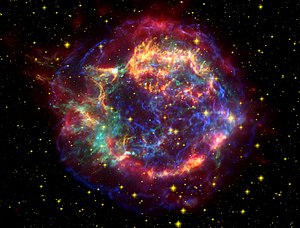Cassiopeia A
| Cassiopeia A | |
|---|---|
| Overlay of images from the Hubble Space Telescope , Chandra Space Telescope, and Spitzer Space Telescope | |
|
Observation dates equinox : J2000.0 , epoch : J2000.0 |
|
| Constellation | Cassiopeia |
| Right ascension | 23 h 23 m 24 s |
| declination | + 58 ° 48.9 ′ 0 ″ |
| Physical data | |
| distance | approx. 11,000 ly |
| diameter | approx. 10 ly |
| Supernova | |
| Type | IIb |
| Other names | |
| SNR G111.7-02.1 • 3C 461 | |
Cassiopeia A ( Cas A ) is a supernova remnant in the constellation Cassiopeia around 11,000 light years away, with a diameter of around 10 light years.
It is the remnant of a supernova explosion that could have been observed on Earth around the year 1680 had it not happened behind clouds of gas and dust. It is possible that the supernova appeared as a sixth magnitude star , which the astronomer John Flamsteed cataloged on August 16, 1680 as the star 3 Cassiopeiae , but which has not been found since then. Today Cassiopeia A is the most powerful extrasolar radio source in the sky. The radio source was discovered in 1947, the optical identification succeeded in 1950. Cassiopeia A was the youngest known supernova remnant in our galaxy until the discovery of supernova remnant G1.9 + 0.3 .
Using a light echo, it was possible to observe the historical supernova spectrally. A light echo is created by the scattering of dust particles in the interstellar matter . Since the dust is outside the Earth's line of sight to the supernova, the path is longer and the explosion can still be examined today. With the help of the MIPS instrument on the Hubble space telescope , the infrared spectrum of the supernova could be examined and therefore belongs to type IIb. Cas A is therefore the supernova remnant of a core collapse supernova of a former red supergiant , which lost its hydrogen-rich atmosphere due to stellar winds before the explosion.
During observations with the Chandra X-ray telescope , a point X-ray source near the center of Cas A = 3C 461 = SNR G111.7-2.1 was found. Since no variability of the source could be found in either the optical or the X-ray range, it is very unlikely that it is a cataclysmic variable in the foreground or an active galactic core in the background of Cas A. The X-ray spectrum can best be described as that of a neutron star with a polar spot at a temperature of around 2.8 million Kelvin .
Web links
- Cassiopeia A - SNR @ caltech.edu, accessed May 16, 2011
- What is Cas A? from the alpha-Centauri television series(approx. 15 minutes). First broadcast on Feb 1, 2006.
- astronews.com: Close look at supernova remnant November 29, 2001
- astronews.com: Splendor of colors in Cassiopeia A July 4th, 2002
- astronews.com: Reunion with Cassiopeia A August 31, 2004
- astronews.com: A fairly lively "dead" star June 10, 2005
- astronews.com: Dusty Supernova Remnant December 21, 2007
- astronews.com: The Secret of Cassiopeia A May 30, 2008
- astronews.com: Picture of the day March 15, 2012
Individual evidence
- ↑ FAZ.net: The echo of a star explosion from June 5, 2008.
- ^ DW Hughes: Did Flamsteed see the Cassiopeia A supernova? In: Nature . tape 285 , 1980, pp. 132-133 , doi : 10.1038 / 285132a0 .
- ↑ Oliver Krause, Stephan M. Birkmann, Tomonori Usuda, Takashi Hattori, Miwa Goto, George H. Rieke, Karl A. Misselt: The Cassiopeia A Supernova was of Type IIb . In: Science . tape 320 , 2008, p. 1195-1197 , doi : 10.1126 / science.1155788 .
- ↑ GG Pavlov, VE Zavlin, B. Aschenbach, J. Trümper, D. Sanwal: The Compact Central Object in Cassiopeia A: A Neutron Star with hot polar caps or a Black Hole? In: The Astrophysical Journal . tape 531 , 2000, pp. L53-L56 , doi : 10.1086 / 312521 .

